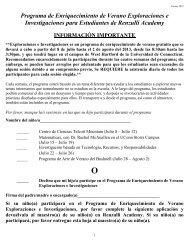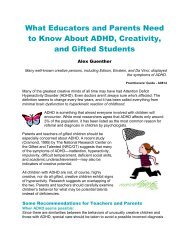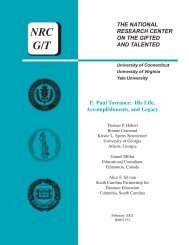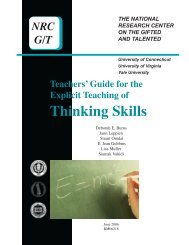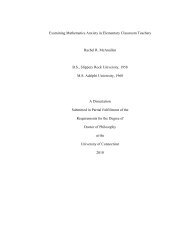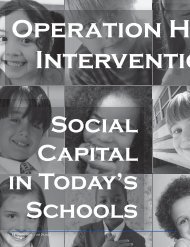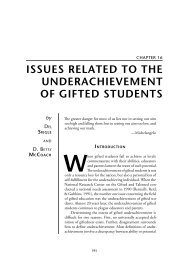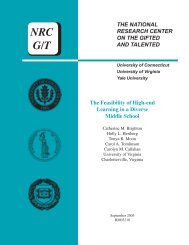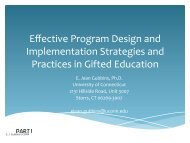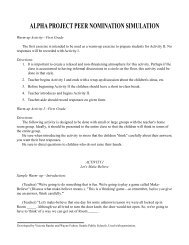Giftedness and High School Dropouts - Neag Center for Gifted ...
Giftedness and High School Dropouts - Neag Center for Gifted ...
Giftedness and High School Dropouts - Neag Center for Gifted ...
You also want an ePaper? Increase the reach of your titles
YUMPU automatically turns print PDFs into web optimized ePapers that Google loves.
12<br />
school, (f) gifted dropouts developed poor peer relationships <strong>and</strong> exhibited poor<br />
social adjustment, (g) there was evidence of lack of counseling in high school <strong>and</strong><br />
inadequate communication between the school <strong>and</strong> the home. (p. i)<br />
Betts <strong>and</strong> Neihart (1988) developed profiles of gifted <strong>and</strong> talented students on the<br />
basis of their feelings <strong>and</strong> attitudes, behaviors, needs, adults <strong>and</strong> peer perceptions of<br />
identification (e.g., Type I; successful, Type IV; dropouts), home support, <strong>and</strong> school<br />
support (see Table 1). According to these profiles, the gifted <strong>and</strong> talented dropouts were<br />
depressed <strong>and</strong> withdrawn because their needs <strong>and</strong> feelings were not addressed. <strong>School</strong><br />
did not support their talents <strong>and</strong> interests, <strong>and</strong> it seemed irrelevant to them. Betts <strong>and</strong><br />
Neihart (1988) recommended family counseling <strong>and</strong> individual counseling to help with<br />
their self-esteem.<br />
Reasons That <strong>Gifted</strong> Students Leave <strong>School</strong><br />
Among the various reasons gifted students drop out of school, low self-concept<br />
has been reported as a significant factor in some research studies (Betts & Neihart, 1988;<br />
Fine, 1986; French, 1969; Gilligan, 1990; Worrell, 1997). That is, gifted students who<br />
dropped out of school have lower self-concepts <strong>and</strong> self-esteem compared with gifted<br />
students who completed school. Worrell (1997) compared gifted at-risk students with<br />
gifted not-at-risk students on individual, environmental, <strong>and</strong> protective factors. Findings<br />
indicated that the at-risk gifted students were significantly different from the gifted<br />
students who were not at risk on seven risk factors: GPA, behavior problems, number of<br />
days spent with friends, number of high schools attended, number of extracurricular<br />
activities, frequency of fights with parents, <strong>and</strong> number of children in the family.<br />
Regarding protective factors, the two groups did differ on academic self-concept but not<br />
on global self-esteem. Robertson (1991) found that, although the reasons <strong>for</strong> dropping<br />
out appear similar between gifted <strong>and</strong> non-gifted students, the underlying motivation is<br />
different. She stated:<br />
<strong>Gifted</strong> dropouts appear on a self-actualizing quest; the w<strong>and</strong>erlust is a means to an<br />
end that may not be fully understood, but is an affective <strong>and</strong> a cognitive<br />
component of identity development as they strive <strong>for</strong> their niche in the world.<br />
Non-gifted dropouts are escaping from the hostile academic world, viewing the<br />
real world as less inimical to them than school. . . . <strong>Gifted</strong> dropouts tend to have<br />
more supportive families, have more money, come from a value system that<br />
encourages self expression <strong>and</strong> development, are non-minority, <strong>and</strong> speak English<br />
as a primary language. (Robertson, 1991, p. 67)




